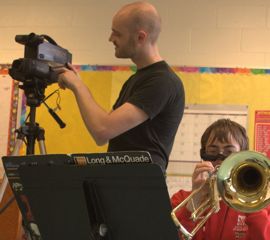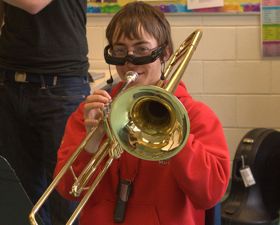Real-Time Conductor Viewer

Josh Yates is a gifted young musician who is passionate about playing the valve trombone and baritone horn in his school bands.
But the 15-year-old's severe tunnel vision – called retinitis pigmentosa – prevented him from simultaneously seeing the music in front of him and using his peripheral vision to see the conductor standing further away. In order to participate, his support worker, Heather Laing, would sit by his side during practices and performances, following the music with her finger and tapping and gesturing to convey tempo and loudness.
 One day, Heather saw a TV feature about CanAssist and immediately thought of Josh.
One day, Heather saw a TV feature about CanAssist and immediately thought of Josh.
A meeting was scheduled, during which Josh was introduced to Peter McGuire, a member of CanAssist's engineering team. Josh explained his wish to be able to play music independently in his middle school's concert and jazz bands.
Peter was given a pair of paper glasses with tiny holes in them so he could understand the limits of Josh's field of view. He also attended one of Josh's concerts to understand how the teen performs.
Peter's plan was to place a live video feed of the conductor into Josh's very limited field of vision. His research led him to a company called MyVu, which sent him a free pair of discontinued video goggles that have an LCD screen embedded in each lens.
“The idea was to bring both the conductor and Josh's music together into a much tighter field of vision,” Peter explains.
He connected a video camera to the goggles with a cable and, by focusing the camera on the conductor, could project a real-time video feed onto the two LCD screens. But Peter discovered that all the newer digital video cameras have a half-second delay between the time the video is captured and the time it is displayed – completely unacceptable for a musician. Fortunately, UVic happened to have an older VHS camcorder where the delay was almost non-existent. Since the camera was no longer being used, it was donated to the project.
 “We really started out with a blank slate, but in the end it was quite a simple solution,” says Peter. “Now Josh only has to glance down very slightly to see the conductor.”
“We really started out with a blank slate, but in the end it was quite a simple solution,” says Peter. “Now Josh only has to glance down very slightly to see the conductor.”
When Josh put on the goggles for the first time, he was thrilled to be able to see the conductor's image, while looking over the glasses to read the sheet music in front of him. He was able to participate in the first band class all on his own.
“Thank you SOOOOOOOOOO much! I really appreciate you putting in all the effort and time that you have,” Josh wrote to us recently. “Honestly, words aren't enough, and I really think it's cool!”
Heather, his support worker, says that Josh has no problem setting up the system and recharging the goggles' batteries. And, of course, every member of the band wants to try out Josh's cool “cyborg” glasses.
“I thoroughly enjoyed sitting about six feet behind him watching him independently play all the music that the rest of the class was playing,” says Heather.
This year, Josh heads to Belmont Secondary. No doubt the teenager – who won an award for overcoming obstacles at Dunsmuir Middle School – will hit all the right notes.
CanAssist would like to thank Myvu, the company that generously donated the video glasses for this project.
(This technology was delivered in June 2010.)
The following video was provided courtesy of CTV Vancouver Island (formerly A-Channel):
Go to CanAssist's Video Gallery to view more technology videos.
Go to Top
